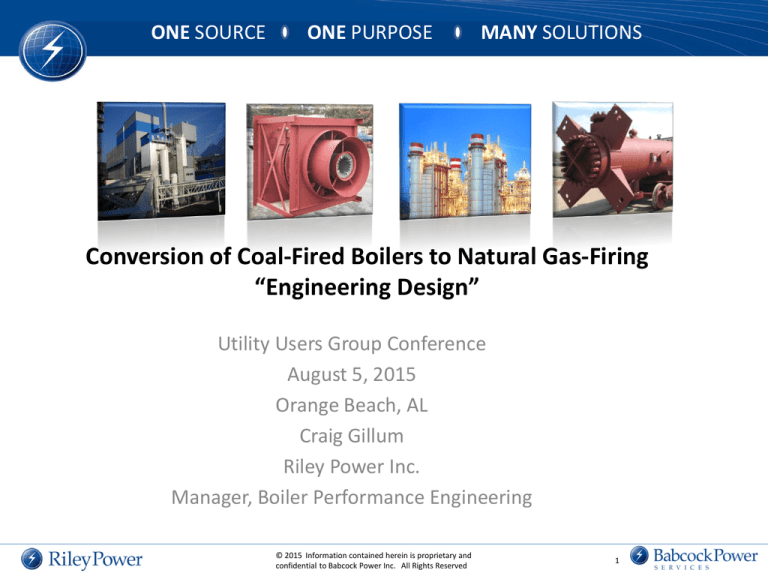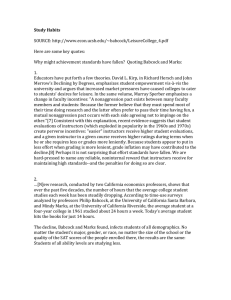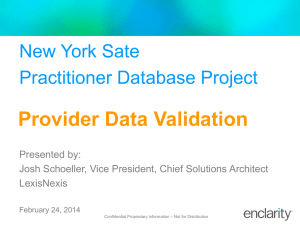
ONE SOURCE
ONE PURPOSE
MANY SOLUTIONS
Conversion of Coal-Fired Boilers to Natural Gas-Firing
“Engineering Design”
Utility Users Group Conference
August 5, 2015
Orange Beach, AL
Craig Gillum
Riley Power Inc.
Manager, Boiler Performance Engineering
© 2015 Information contained herein is proprietary and
confidential to Babcock Power Inc. All Rights Reserved
1
Recent News
© 2015 Information contained herein is proprietary and
confidential to Babcock Power Inc. All Rights Reserved
2
Conversion of Coal-Fired Boilers to Natural Gas-Firing
Phases of a NG Conversion Project
1. Economics
2. Permitting / Environmental
3. Bid Process
4. Design
Engineering
5. Construction
6. Start-up
7. Performance Results
© 2015 Information contained herein is proprietary and
confidential to Babcock Power Inc. All Rights Reserved
3
NG Conversion
Burner
Design Engineering
• Fuel Combustion System
• Boiler Performance
• Boiler Auxiliary
Equipment
Heat Transfer
• BOP
Not “stand-alone”
systems.
All work together.
Fans
© 2015 Information contained herein is proprietary and
confidential to Babcock Power Inc. All Rights Reserved
4
NG Conversion Considerations
Design Engineering
Up-Front Decisions by the Utility
1. Establish the Fuel Firing Matrix:
• 100% Gas-Firing Only
• Co-Fire NG and Coal
• Dual-Fuel Capability (100% NG and 100%
Coal)
2. Establish Emissions Requirements:
•
Emissions drives Combustion System design
which in-turn impacts the Boiler
Performance and Auxiliary Equipment
Performance (Fans & AH).
© 2015 Information contained herein is proprietary and
confidential to Babcock Power Inc. All Rights Reserved
5
NG Conversion Considerations
Up-Front Decisions by the Utility (cont.)
3. Establish Required Thermal Performance:
•
•
•
•
Capacity
Steam Temperature
Efficiency
Turndown range
4. Establish Design Constraints:
• Pressure part modifications
• FGR
• Auxiliary equipment modifications
o Fans
o Air heater
© 2015 Information contained herein is proprietary and
confidential to Babcock Power Inc. All Rights Reserved
6
Combustion System Design to Meet Emissions
Design Process
Establish
Fuel Firing
Matrix
Establish
Emissions
Requirements
Combustion
System
Design to
Meet
Emissions
© 2015 Information contained herein is proprietary and
confidential to Babcock Power Inc. All Rights Reserved
Evaluate
Boiler
Performance
Evaluate
Auxiliary
Equipment
(Fans & AH)
7
Typical Low NOx Combustion Design Process
Combustion System
Design Sequence
(to meet emissions)
Low NOx Coal Flame
Tflame ~ 3,000 – 3,300 [F]
First:
Analyze Burners Only
Second:
Burners and Over-fire Air (OFA)
Third:
Burners + OFA + Flue Gas
Recirculation (FGR)
© 2015 Information contained herein is proprietary and
confidential to Babcock Power Inc. All Rights Reserved
8
Combustion System Design to Meet Emissions
If Combustion System Alone Cannot Meet
Emissions; Added Emissions Control Equipment is
Required.
Design Process
Establish
Fuel Firing
Matrix
Establish
Emissions
Requirements
Add NG
Combustion
System
Options
Add SNCR
or SCR
© 2015 Information contained herein is proprietary and
confidential to Babcock Power Inc. All Rights Reserved
Evaluate
Boiler
Performance
Evaluate
Auxiliary
Equipment
(Fans & AH)
9
Indicative NOx & CO Emissions
Wall Fired NG Emissions
Emissions – Utility Boiler
Coal Burner
retrofit w/NG
Firing Capability
NOx
(lb/mmbtu)
CO
(ppm @ 3% O2)
Bituminous Coal w/OFA
0.27 – 0.32
<100
PRB Coal w/OFA
0.17 – 0.20
<300
NG w/OFA
0.22 – 0.30
<100
NG w/ OFA & FGR
0.09 – 0.15
<100
NG Burner
Complete
Replacement
Emissions – Utility Boiler
NOx
(lb/MMBtu)
CO
(ppm @ 3% O2)
Burner
0.25 – 0.32
<100
Burner w/OFA
0.18 – 0.24
<100
Burner w/OFA + FGR
0.07 – 0.12
<100
© 2015 Information contained herein is proprietary and
confidential to Babcock Power Inc. All Rights Reserved
10
Indicative NOx & CO Emissions
Tangential Fired NG Emissions
T-Fired Burner w/NG
Emissions – Utility Boiler
NOx
(lb/mmbtu)
CO
(ppm @ 3% O2)
BNR Only
0.15 - 0.20
<150
BNR / SOFA
0.10 - 0.15
<150
BNR / SOFA / FGR
0.06 - 0.10
<150
© 2015 Information contained herein is proprietary and
confidential to Babcock Power Inc. All Rights Reserved
11
Emissions Range is due to:
Natural Gas Flame
Tflame ~ 3,200 – 3,500 [F]
• Furnace Size
Basket Area Heat Release
(Hot box vs Cold Box)
• Retention Time
Bnr & OFA to Furnace Exit
(Tall vs short furnace)
• Furnace Depth
Flame Length Control
• Burner Design
Types of Air & Fuel Mixing
© 2015 Information contained herein is proprietary and
confidential to Babcock Power Inc. All Rights Reserved
12
Conversion of Existing Coal-Fired Boilers
Various Utility Firing Configurations
1) Wall-Fired
: Typically associated
w/Riley, Foster Wheeler
and B&W Boilers
2) Tangential-Fired : CE/Alstom Boilers
Each has their own characteristics on both
the combustion and heating surface design
© 2015 Information contained herein is proprietary and
confidential to Babcock Power Inc. All Rights Reserved
13
Wall Fired
Dual Fuel
Coal/NG
Existing Burner Retrofit
© 2015 Information contained herein is proprietary and
confidential to Babcock Power Inc. All Rights Reserved
14
CFD Furnace Modeling-Wall Fired Furnace Design
Burners located on the Front and/or Rear Walls
CFD Model – Wire Frame
Temperature
CO Emissions
FEGT
Plane
OFA Ports Plane
Wall-Fired Furnace
Example: 365 MW Unit – LNB & OFA – PRB Coal
© 2015 Information contained herein is proprietary and
confidential to Babcock Power Inc. All Rights Reserved
15
Wall Fired - Dual Fuel - VS III® LNB for Coal and NG Gun Retrofit
• Center fired gas gun with
pneumatic retraction
• Dual head UV/IR flame
scanners
Retractable
main gas gun
CCV® Coal
Nozzle
Retractable
Gas Gun
Dual Fuel
“Smart” Scanners
CCV® Coal Nozzle
© 2015 Information contained herein is proprietary and
confidential to Babcock Power Inc. All Rights Reserved
16
Wall Fired - Dual Fuel Retrofit Option: Gas Ring Retrofit w/Existing Coal Burner
• RPI VS III® LNB or
reuse existing
burner air registers
with components
retrofit
Gas Ring w/Spuds
• Coal
– CCV nozzle
– SA / TA diverters
• Gas
– Ring header with
spuds
CCV® Coal Nozzle
– Center fired gas gun
© 2015 Information contained herein is proprietary and
confidential to Babcock Power Inc. All Rights Reserved
17
Wall Fired
NG Firing Only
Burner Replacement
© 2015 Information contained herein is proprietary and
confidential to Babcock Power Inc. All Rights Reserved
18
Wall Fired – Gas Only STS® Low NOx Gas Burner Replacement
© 2015 Information contained herein is proprietary and
confidential to Babcock Power Inc. All Rights Reserved
19
Wall Fired – Gas Only - STS® Low NOx Gas Burner Utility Design
•
•
•
•
•
•
•
•
•
Plug-in design
Burner capacity 30 to 250 MMBtu/hr heat
input
Low burner air pressure drop typically less
than 5” WC
Independent flow and swirl control for
flame shaping
Primary Air/ Secondary Air flow split
control to minimize NOx
Burner to burner air flow balancing biasing
capability to correct unbalanced windboxes
Automatic air shroud to control
Windbox/Furnace differential pressure
Ability to eliminate combustion induced
vibration with online adjustable gas canes
High mechanical reliability from proven
register design
© 2015 Information contained herein is proprietary and
confidential to Babcock Power Inc. All Rights Reserved
20
STS ® LNB - Adjustable Gas Canes
• Tip position adjustment
– Axial
– Rotational
• Adjustable w/ burner online
– Remove cap (14)
– Loosen lock nut (5)
– Turn drive nut (4)
• Field tuning adjustable for
emissions & vibration
© 2015 Information contained herein is proprietary and
confidential to Babcock Power Inc. All Rights Reserved
21
Tangentially Fired
Dual Fuel
&
Gas Only
© 2015 Information contained herein is proprietary and
confidential to Babcock Power Inc. All Rights Reserved
22
Tangentially Fired Dual Fuel & Gas Only
Tangential -Fired Utility Furnace
CFD Model
Furnace
Modeling
Corner Fuel & Air Ports
Corner Fired
© 2015 Information contained herein is proprietary and
confidential to Babcock Power Inc. All Rights Reserved
Circular Rotation
23
Tangentially Fired – Coal & Gas
Tangentially Fired Dual
Fuel & Gas Retrofit
• Install gas spuds in
existing auxiliary air
compartments
Coal
compartments
Aux Air compartments
w/ gas spuds & tips
• Add igniters to aux air
compartments or Side
horn Ignitors
© 2015 Information contained herein is proprietary and
confidential to Babcock Power Inc. All Rights Reserved
24
Tangentially Fired Dual Fuel & Gas Retrofit
Gas Spuds
Gas Tip
(Angle
adjustable)
Gas Spud
(Stationary)
© 2015 Information contained herein is proprietary and
confidential to Babcock Power Inc. All Rights Reserved
25
Over Fire Air
(OFA)
© 2015 Information contained herein is proprietary and
confidential to Babcock Power Inc. All Rights Reserved
26
OFA Systems
OFA: Staged Combustion
• % of Combustion Air Injected
Above the burners
• Used for NOx Control
•
•
Important design features from RPI study for
EPRI
– Location
– Uniform distribution
– Penetration (adequate pressure and
velocity)
– Mixing
– Turndown (1/3, 2/3 area flow control
dampers)
– Biasing capabilities
Major components
– Individual nozzles located above each
burner column
– OFA ports use 1/3 - 2/3 nozzle design
with individual dampers with automatic
control
© 2015 Information contained herein is proprietary and
confidential to Babcock Power Inc. All Rights Reserved
27
Separated OFA System Arrangement
T-Fired Boiler
SOFA
Windbox
© 2015 Information contained herein is proprietary and
confidential to Babcock Power Inc. All Rights Reserved
28
Flue Gas
Recirculation
(FGR)
© 2015 Information contained herein is proprietary and
confidential to Babcock Power Inc. All Rights Reserved
29
Conversion of Existing Coal-Fired Boilers
Flue Gas Recirculation
(FGR)
Flue gas recirculated back
to the Furnace
• NOx Control:
- FGR Through the Burners
• Steam Temp Control:
- FGR Through the Furnace
Bottom
© 2015 Information contained herein is proprietary and
confidential to Babcock Power Inc. All Rights Reserved
30
Flue Gas Recirculation Systems
1. FGR from Economizer Exit
2. FGR From Airheater Exit
3. “Induced” FGR from ID Fan to FD Fan
© 2015 Information contained herein is proprietary and
confidential to Babcock Power Inc. All Rights Reserved
31
Boiler
Performance
© 2015 Information contained herein is proprietary and
confidential to Babcock Power Inc. All Rights Reserved
32
Boiler Performance
• SH / RH Steam
Temperature
• AH Exit flue gas
temperature
• Boiler Efficiency
© 2015 Information contained herein is proprietary and
confidential to Babcock Power Inc. All Rights Reserved
33
Boiler Thermal Modeling
Two Main Types of Models:
1. Theoretical Model
– Based on a Text Book Analysis
2. Calibrated Model
– Based on Calibration to Actual Data
Uses
– Predict Performance at New Physical
Operating Conditions
– “What-If” Analysis
– Sensitivity Analysis, “Bound the Solution”
– Evaluate the Complete System “Big Picture”
Input Requirements
– Detail Physical Arrangement
– Design Operating Condition
– Actual Data for Calibration
© 2015 Information contained herein is proprietary and
confidential to Babcock Power Inc. All Rights Reserved
34
NG Firing Facts Concerning Boiler Performance
1.
Furnace Exit Gas Temperature
• Expect some change
• Dependent on design coal
2.
Surface Fouling Characteristics
• Furnace & Convection surfaces are cleaner & more effective
3.
Flue Gas Flows Produced
• Coal firing excess air 18 – 24 %
• NG firing excess air 8 – 10%
• Overall NG firing flue gas flow reduce 7-12 %.
4.
SH / RH Steam Temperatures
• Typically SH / RH temperatures reduce (10-60 ͦF)
• Temperature or spray will reduce
• Depends on original coal characteristics and amount of radiant surface
Note: Adding FGR for NOx control can improve steam temperatures.
© 2015 Information contained herein is proprietary and
confidential to Babcock Power Inc. All Rights Reserved
35
Boiler Performance Firing Natural Gas
Con’t.
5.
If Flue Gas Recirculation (FGR) is Used for NOx Control.
• Flue gas flow rate will increase 5 – 20% (as required for NOx control)
• Increases SH / RH steam temperatures and increasing LTSH tube metals.
6.
Economizer exit and AH exit gas temperatures
• Typically Flue Gas Temperatures decrease
• Note: AH performance changes with the elimination of coal pulverizer
tempering air.
7.
SH / RH Tube Metals
•
•
•
8.
SH / RH Tube metal temperatures typically do not change firing NG except:
First bundle out of furnace
When FGR is used. FGR increases the convective pass heat absorption that in-turn
increases the LTSH temperature (before spray).
Boiler Efficiency
• Boiler efficiency firing NG reduces by 3 – 5% due to the increased Hydrogen (H2)
moisture loss.
© 2015 Information contained herein is proprietary and
confidential to Babcock Power Inc. All Rights Reserved
36
Furnace Performance
Furnace Exit Gas Temperature
• Flame
Characteristics
• Furnace
Cleanliness
• Furnace Size
Circulation
• Slight change in
heat absorption
profile
• No Change in
boiler circulation
Gas Temperature
Furnace Exit Gas
Temperature
(FEGT)
Bituminous Coal
Bituminous Coal - Severe
Slagging
Bituminous Coal - Low
Slagging
PRB Coal
Natural Gas
Furnace Area Heat Release
© 2015 Information contained herein is proprietary and
confidential to Babcock Power Inc. All Rights Reserved
37
• Due to changes in
radiant absorption
and gas
temperature and
flow, heat transfer
in convection
sections will
typically decrease.
• FGR is one way to
increase the
convection by
increasing gas flow.
Normalized Gas Enthalpy
Change in Convective Heat Transfer
1.00
Coal Base
0.80
Nat. Gas
0.60
Nat. Gas w/
FGR
0.40
0.20
0.00
© 2015 Information contained herein is proprietary and
confidential to Babcock Power Inc. All Rights Reserved
38
Fuel Analysis Comparison
PRB
Bituminous
Natural Gas
H2 O
C
29.34
48.43
2.9
80.31
0
73.21
H2
3.57
4.47
23.2
O2
12.62
2.85
0.45
N2
S
Ash
Total
HHV (BTU/lb)
0.71
0.25
5.08
100
8,223
1.38
1.54
6.55
100
14,100
3.14
0
0
100
22,738
Efficiency (%)
Fuel Flow (pph)
Flue Gas Flow
84.35
713,930
6,018,886
89.45
391,068
5,457,221
83.70
259,166
4,985,251
Qout.steam (KBTU/hr)
4,951,890
4,932,326
4,932,371
© 2015 Information contained herein is proprietary and
confidential to Babcock Power Inc. All Rights Reserved
39
Conversion of Existing Coal-Fired Boilers
Boiler Efficiency Changes
• Highly dependent on existing fuel characteristics
• In general, a decrease in boiler efficiency of more than 5% can occur.
• 1:1 change in unit heat rate with change in boiler efficiency
η = 89.45%
η = 84.27%
η = 83.79%
(-5.7% ∆η from Bit.)
(-0.5% ∆η from PRB)
© 2015 Information contained herein is proprietary and
confidential to Babcock Power Inc. All Rights Reserved
40
NERC GADS Lost Generation Data
100,000
80,000
60,000
Boiler Tube Leaks
40,000
20,000
Boiler Tube Leaks
0
Coal
Gas
Boiler Fuel Supply To Bunker
Boiler Fuel Supply From Bunkers T
Boiler Piping System
Boiler Internals And Structures
Slag And Ash Removal
Boiler Tube Leaks
Boiler Tube Fireside Slagging Or
Miscellaneous Boiler Tube Problem
Boiler Air And Gas Systems
Boiler Control Systems
Boiler Overhaul And Inspections
Boiler Water Condition
Boiler Design Limitations
Miscellaneous (Boiler)
© 2015 Information contained herein is proprietary and
confidential to Babcock Power Inc. All Rights Reserved
41
NG Conversion
Recommendation
Perform an
“Up-Front Engineering Study”
Benefits
• More in depth analysis
• Evaluates Alternatives (“What if” analysis)
• Considers both Technical and Financial Aspects
• Evaluates the Total System (load range, effects on other equipment)
• Establishes a Better Project Plan
• Better Defines Project Costs and Reduces Risks
• Reduces Project “Surprises”
• Reduces Disagreements and Misunderstandings
• Typically “In the Long Run”, Saves Money $$
© 2015 Information contained herein is proprietary and
confidential to Babcock Power Inc. All Rights Reserved
42
Key Take-Away
Every Boiler is Different
Front End Feasibility Study is Best
Overall Performance Impact is Highly Dependent on Base Fuel
Boiler Efficiency Decrease
Aux. Power Load Decrease
May Require Design Change to Address Convective Changes
Potential for Increased Flexibility
© 2015 Information contained herein is proprietary and
confidential to Babcock Power Inc. All Rights Reserved
43
Questions
&
Thank You
© 2015 Information contained herein is proprietary and
confidential to Babcock Power Inc. All Rights Reserved
44
Extra Sides for
Reference
© 2015 Information contained herein is proprietary and
confidential to Babcock Power Inc. All Rights Reserved
45
45
Conversion of Existing Coal-Fired Boilers
Unit Net Heat Rate
• Boiler efficiency is a 1:1 inverse relationship to unit heat rate.
– 1% decrease in boiler efficiency is a 1% increase in heat rate.
• Steam temperature will effect heat rate also.
• Gas Firing results in a net decrease
of auxiliary power
–
–
–
–
Mill power
I.D. Fan Power
SOx Removal Systems
ESP Power
© 2015 Information contained herein is proprietary and
confidential to Babcock Power Inc. All Rights Reserved
46
Conversion of Existing Coal-Fired Boilers
Burner Ignitor Systems
Classification
Class I
Ignition of Main
Burner
Ignite or support
Heat Input
>10% burner heat input
< 4% burner heat input
Only spark for ignition
Continuous
Operation
Yes
Not permissible
No
Trial for Ignition
Period
10 – 15 s for gas & oils
10 – 15 s for gas & oils
10 – 15 s for gas & oils
Extended Operating
Range
Support combustion of the
main flames
Cannot be used to support
ignition or extend the
turndown range
Cannot be used to support
ignition or extend the
turndown range
Flame Detection
Master Fuel Trip
(MFT) Requirement
Class III
Small ignitor for gas and oil Provides direct spark ignition
burners under prescribed
to ignite main burner
light-off conditions
One detector to prove either One detector required for
the ignitor or main flame.
main burner and ignitor
Does not require MFT
Requires 1-minute delay
before restart
Class III Special
Does not require MFT
Requires 1-minute delay
before restart
© 2015 Information contained herein is proprietary and
confidential to Babcock Power Inc. All Rights Reserved
Only require main flame
detector
Failure of first burner to light
requires MFT
47
Background
• Natural Gas-Firing
– No SOx emissions
– Virtually no PM
– ~1/3 the NOx emissions of coal
w/FGR
– 50-80% less CO2 than coal
© 2015 Information contained herein is proprietary and
confidential to Babcock Power Inc. All Rights Reserved
48
STS® Low NOx Gas Burner – Industrial Design
© 2015 Information contained herein is proprietary and
confidential to Babcock Power Inc. All Rights Reserved
Manually Adjustable Secondary Air
Swirl Vanes
Automatic Modulating Total Air
flow Control Shroud
Manual Control of the Primary and
Secondary Air Flow Split
Air Flow Measurement
High level of NOx reduction
Superior mechanical reliability
Monitoring of burner temperatures
49
STS® Low NOx Gas Burner – Industrial Desi RPI STS® Burner Technology for Industrial
Design
Burner capacity 40 to 250 mmBtu/hr
heat input
NOx reductions up to 60% from
uncontrolled NOx
Independent air flow and swirl control
Low CO emissions
Low burner air pressure drop typically
less than 5 iwc
Burner to burner air flow balancing
biasing capability to correct unbalanced
windboxes
High mechanical reliability from proven
register design
Can be retrofitted to wall-fired
applications without modification of
burner throat tube opening
Can be adapted to accommodate
existing windbox openings
Flame shaping capability
© 2015 Information contained herein is proprietary and
confidential to Babcock Power Inc. All Rights Reserved
50
© 2015 Information contained herein is proprietary and
confidential to Babcock Power Inc. All Rights Reserved
51
Boiler Efficiency
PRB Fuel (18% XSA)
Bituminous Fuel (20 % XSA)
1% 1% 2%
1%
Natural Gas Fuel (10 % XSA)
1%
1% 3%
0%
2%
Dry Flue Gas Loss
Moist. (Liquid) in Fuel
Loss
Water from Hydrogen
Combustion
Air Moisture Loss
30%
30%
39%
33%
59%
0%
67%
28%
Ƞ= 84.35%
2%
Ƞ= 89.45%
© 2015 Information contained herein is proprietary and
confidential to Babcock Power Inc. All Rights Reserved
Ƞ= 83.70%
52
Unburned Carbon
Loss
PRB Fuel (18% XSA)
0.1%
Bituminous Fuel (20 % XSA)
1.2%
Natural Gas Fuel (10 % XSA)
0.2% 4.3%
1.1%
1.2%
8.4%
0.0%
12.0%
21.1%
21.1%
3.1%
14.0%
2.0%
CO2
O2
N2
3.6%
Ar
SO2
66.2%
69.7%
© 2015 Information contained herein is proprietary and
confidential to Babcock Power Inc. All Rights Reserved
H2O
70.8%
53
© 2015 Information contained herein is proprietary and
confidential to Babcock Power Inc. All Rights Reserved
54







